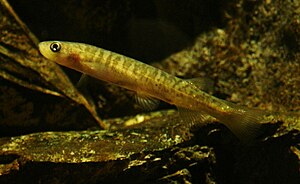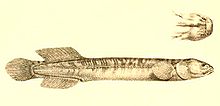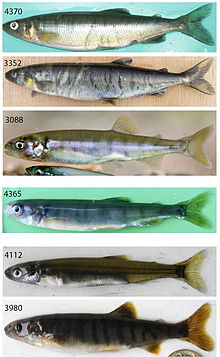Galaxies
| Galaxies | ||||||||||||
|---|---|---|---|---|---|---|---|---|---|---|---|---|

Galaxias vulgaris |
||||||||||||
| Systematics | ||||||||||||
|
||||||||||||
| Scientific name of the order | ||||||||||||
| Galaxiiformes | ||||||||||||
| Berg , 1940 | ||||||||||||
| Scientific name of the family | ||||||||||||
| Galaxiidae | ||||||||||||
| Müller , 1844 |
Galaxies (Galaxiidae) are a family of small minnows - or trout-like freshwater fish , which in the temperate zone in the southern hemisphere are the ecological equivalent of the salmon fish (Salmonidae) in the northern hemisphere. In German they are also called Hechtlinge , a name that is also used for various egg-laying toothcarps that are not related to the Galaxiidae .
distribution
They live in cold fresh waters in Australia (approx. 25 species), Tasmania (15 species), New Zealand (22 species), Lord Howe Island , the Chatham Islands , the Auckland Islands and Campbell Island , in New Caledonia (1 species) , southernmost South Africa (1 species), southern South America (4 species) and the Falkland Islands . Galaxias maculatus inhabits a large part of the family's range. This was explained by the theory of continental drift . It has now been shown that populations from the western and eastern Pacific are genetically very similar and that the wide distribution of the species can be explained by the marine larval stage.
features
Galaxies are elongated, trout-like or minnow-like, scale-less fish that can be three to a maximum of 60 cm long. Her hull is without a honey keel, there is a sideline . The caudal fin has 12 to 14 branched main fin rays. The dorsal and anal fins face each other and are far behind the center of the body. The maxillary , ploughshare , palatine bone and basibranchial (bones at the base of the branchial arch) are edentulous. The gonads are created in pairs.
Way of life
Galaxies live in cool summer waters in the temperate zone of the southern hemisphere. They feed on aquatic insects and approach food (insects that fall into the water) and are good jumpers. Many species of galaxies (unlike the anadromous salmon fish) are catadromous migratory fish that migrate downstream to the estuary to lay eggs. The development of eggs and larvae takes place in the sea. The fry later migrate back into the freshwater. Many species are short-lived, some only have a one-year life cycle.
|
Phylogenetic position of the galaxies
|
External system
The galaxies were previously placed in the order of the smelt-like (Osmeriformes) and formed the superfamily Galaxioidea with the New Zealand salmon (Retropinnidae) and Lepidogalaxias salamandroides (family Lepidogalaxiidae) . According to a more recent phylogenetic investigation, however, the family is outside of the smelt-like family and is the sister group of the pike-like (Esociformes) and the salmon-like (Salmoniformes), while the smelt-like (without Lepidogalaxias ) is the sister group of the deep-sea muzzle (Stomiiformes). In the latest revision of the bony fish systematics, the galaxies are therefore given a ranking (Galaxiiformes). Together with the golden salmon-like (Argentiniformes), the pike-like and the salmon-like, the Galaxiiformes form the sub-cohort Protacanthopterygii .
Internal system
There are two subfamilies, seven genera and about 65 species:
Subfamily Galaxiinae
The approximately 60 species from the subfamily Galaxiinae are scaly and have no adipose fin . They have 37 to 66 vertebrae.

- Genus Brachygalaxias Eigenmann, 1928
- Chile pike ( Brachygalaxias bullocki (Regan, 1908))
- Brachygalaxias gothei Busse, 1983
- Genus Galaxias Cuvier, 1816
- Galaxias aequipinnis Raadik, 2014
- Galaxias anomalus Stokell, 1959
- Galaxias arcanus Raadik, 2014
- Galaxias argenteus (Gmelin, 1789)
- Golden Galaxy ( Galaxias auratus Johnston, 1883)
- Climbing Galaxy ( Galaxias brevipinnis Günther, 1866)
- Galaxias brevissimus Raadik, 2014
- Galaxias cobitinis McDowall & Waters, 2002
- Galaxias depressiceps McDowall & Wallis, 1996
- Galaxias divergens Stokell, 1959
- Galaxias eldoni McDowall, 1997
- Galaxias fasciatus Gray, 1842
- Galaxias fontanus Fulton, 1978
- Galaxias fuscus Mack, 1936
- Galaxias globiceps Eigenmann, 1928
- Galaxias gollumoides McDowall & Chadderton, 1999
- Galaxias gracilis McDowall, 1967
- Galaxias gunaikurnai Raadik, 2014
- Galaxias johnstoni Scott, 1936
- Galaxias lanceolatus Raadik, 2014
- Galaxias longifundus Raadik, 2014
- Galaxias macronasus McDowall & Waters, 2003
- Speckled Galaxy ( Galaxias maculatus (Jenyns, 1842))
- Galaxias mcdowalli Raadik, 2014
- Galaxias mungadhan Raadik, 2014
- Galaxias neocaledonicus Weber & de Beaufort, 1913
- Galaxias niger Andrews, 1985
- Galaxias occidentalis Ogilby, 1899
- Mountain galaxy ( Galaxias olidus Günther, 1866)
- Galaxias oliros Raadik, 2014
- Galaxias ornatus Castelnau, 1873
- Galaxias parvus Frankenberg, 1968
- Galaxias paucispondylus Stokell, 1938
- Galaxias pedderensis Frankenberg, 1968
- Galaxias platei Steindachner, 1898
- Galaxias postvectis Clarke, 1899
- Galaxias prognathus Stokell, 1940
- Galaxias pullus McDowall, 1997
- Galaxias rekohua Mitchell, 1995
- Flat-headed galaxy ( Galaxias rostratus Klunzinger, 1872)
- Galaxias supremus Raadik, 2014
- Galaxias tantangara Raadik, 2014
- Galaxias tanycephalus Fulton, 1978
- Galaxias terenasus Raadik, 2014
- Trout Galaxy ( Galaxias truttaceus Valenciennes, 1846)
- Galaxias vulgaris Stokell, 1949
- Cape Galaxy ( Galaxias zebratus (Castelnau, 1861))
- Genus Galaxiella McDowall, 1978
- Mud dwarf galaxy ( Galaxiella munda McDowall, 1978)
- Black Stripe Dwarf Galaxy ( Galaxiella nigrostriata (Shipway, 1953))
- Galaxiella pusilla (Mack, 1936)
- Galaxiella toourtkoourt Coleman & Raadik, 2015
- Genus Neochanna Günther, 1867
- Neochanna apoda Günther, 1867
- Neochanna burrowsius (Phillipps, 1926)
- Tasmanian mudfish ( Neochanna cleaveri (Scott, 1934))
- Neochanna diversus Stokell, 1949
- Neochanna heleios Ling & Gleeson, 2001
- Genus Paragalaxias Scott, 1935
- Paragalaxias dissimilis (Regan, 1906)
- Paragalaxias eleotroides McDowall & Fulton, 1978
- Paragalaxias julianus McDowall & Fulton, 1978
- Tasmanian Paragalaxy ( Paragalaxias mesotes McDowall & Fulton, 1978)
Subfamily Aplochitoninae
The four species of trout pike (subfamily Aplochitoninae) are 7.7 to 38 centimeters long, have no scales and have an adipose fin and 52 to 74 vertebrae.
- Genus Aplochiton Jenyns, 1842
- Aplochiton marinus Eigenmann 1928.
- Aplochiton taeniatus Jenyns, 1842
- Falkland trout ( Aplochiton zebra Jenyns, 1842)
- Genus Lovettia McCulloch, 1915
- Lovettia sealii (Johnston, 1883)
Fossil record
Fossil galaxies of the genus Galaxias are known from New Zealand. May need Stompooria from the Late Cretaceous period are also provided by South Africa to the family.
literature
- Kurt Fiedler: Textbook of Special Zoology, Volume II, Part 2: Fish . Gustav Fischer Verlag, Jena 1991, ISBN 3-334-00339-6
- Joseph S. Nelson : Fishes of the World . John Wiley & Sons, 2006, ISBN 0-471-25031-7
Individual evidence
- ↑ R. Betancur-R., E. Wiley, N. Bailly, A. Acero, M. Miya, G. Lecointre, G. Ortí: Phylogenetic Classification of Bony Fishes - Version 4 (2016)
- ↑ Ricardo Betancur-R, Edward O. Wiley, Gloria Arratia, Arturo Acero, Nicolas Bailly, Masaki Miya, Guillaume Lecointre and Guillermo Ortí: Phylogenetic classification of bony fishes . BMC Evolutionary Biology, BMC series - July 2017, DOI: 10.1186 / s12862-017-0958-3
- ↑ a b c d e f g h i j k l m Tarmo A. Raadik: Fifteen from one: a revision of the Galaxias olidus Günther, 1866 complex (Teleostei, Galaxiidae) in south-eastern Australia recognizes three previously described taxa and describes 12 new species. Zootaxa 3898 (1): 001–198 (Dec. 2014) doi: 10.11646 / zootaxa.3898.1.1
Web links
- Galaxies on Fishbase.org (English)






